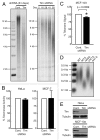Timeless preserves telomere length by promoting efficient DNA replication through human telomeres
- PMID: 22672906
- PMCID: PMC3383593
- DOI: 10.4161/cc.20810
Timeless preserves telomere length by promoting efficient DNA replication through human telomeres
Abstract
A variety of telomere protection programs are utilized to preserve telomere structure. However, the complex nature of telomere maintenance remains elusive. The Timeless protein associates with the replication fork and is thought to support efficient progression of the replication fork through natural impediments, including replication fork block sites. However, the mechanism by which Timeless regulates such genomic regions is not understood. Here, we report the role of Timeless in telomere length maintenance. We demonstrate that Timeless depletion leads to telomere shortening in human cells. This length maintenance is independent of telomerase, and Timeless depletion causes increased levels of DNA damage, leading to telomere aberrations. We also show that Timeless is associated with Shelterin components TRF1 and TRF2. Timeless depletion slows telomere replication in vitro, and Timeless-depleted cells fail to maintain TRF1-mediated accumulation of replisome components at telomeric regions. Furthermore, telomere replication undergoes a dramatic delay in Timeless-depleted cells. These results suggest that Timeless functions together with TRF1 to prevent fork collapse at telomere repeat DNA and ensure stable maintenance of telomere length and integrity.
Figures







Comment in
-
Timeless tunes: replicating happy endings.Cell Cycle. 2012 Aug 15;11(16):2977-8. doi: 10.4161/cc.21530. Epub 2012 Aug 9. Cell Cycle. 2012. PMID: 22874596 Free PMC article.
Similar articles
-
TIN2 binds TRF1 and TRF2 simultaneously and stabilizes the TRF2 complex on telomeres.J Biol Chem. 2004 Nov 5;279(45):47264-71. doi: 10.1074/jbc.M409047200. Epub 2004 Aug 16. J Biol Chem. 2004. PMID: 15316005
-
Telomere-bound TRF1 and TRF2 stall the replication fork at telomeric repeats.Nucleic Acids Res. 2004 Mar 8;32(5):1627-37. doi: 10.1093/nar/gkh309. Print 2004. Nucleic Acids Res. 2004. PMID: 15007108 Free PMC article.
-
AKTIP/Ft1, a New Shelterin-Interacting Factor Required for Telomere Maintenance.PLoS Genet. 2015 Jun 25;11(6):e1005167. doi: 10.1371/journal.pgen.1005167. eCollection 2015 Jun. PLoS Genet. 2015. PMID: 26110528 Free PMC article.
-
Timeless protection of telomeres.Curr Genet. 2016 Nov;62(4):725-730. doi: 10.1007/s00294-016-0599-x. Epub 2016 Apr 11. Curr Genet. 2016. PMID: 27068713 Free PMC article. Review.
-
Post-translational modifications of TRF1 and TRF2 and their roles in telomere maintenance.Mech Ageing Dev. 2012 Jun;133(6):421-34. doi: 10.1016/j.mad.2012.05.002. Epub 2012 May 23. Mech Ageing Dev. 2012. PMID: 22634377 Review.
Cited by
-
Modified iPOND revealed the role of mutant p53 in promoting helicase function and telomere maintenance.Aging (Albany NY). 2023 Oct 12;15(19):10767-10784. doi: 10.18632/aging.205117. Epub 2023 Oct 12. Aging (Albany NY). 2023. PMID: 37827695 Free PMC article.
-
Modulation of ATR-mediated DNA damage checkpoint response by cryptochrome 1.Nucleic Acids Res. 2014 Apr;42(7):4427-34. doi: 10.1093/nar/gku094. Epub 2014 Jan 30. Nucleic Acids Res. 2014. PMID: 24489120 Free PMC article.
-
Canonical and non-canonical functions of the non-coding RNA component (TERC) of telomerase complex.Cell Biosci. 2025 Mar 1;15(1):30. doi: 10.1186/s13578-025-01367-0. Cell Biosci. 2025. PMID: 40025596 Free PMC article. Review.
-
Timeless tunes: replicating happy endings.Cell Cycle. 2012 Aug 15;11(16):2977-8. doi: 10.4161/cc.21530. Epub 2012 Aug 9. Cell Cycle. 2012. PMID: 22874596 Free PMC article.
-
The Replisome Mediates A-NHEJ Repair of Telomeres Lacking POT1-TPP1 Independently of MRN Function.Cell Rep. 2019 Dec 10;29(11):3708-3725.e5. doi: 10.1016/j.celrep.2019.11.012. Epub 2019 Dec 10. Cell Rep. 2019. PMID: 31825846 Free PMC article.
References
Publication types
MeSH terms
Substances
Grants and funding
LinkOut - more resources
Full Text Sources
Research Materials
Miscellaneous
